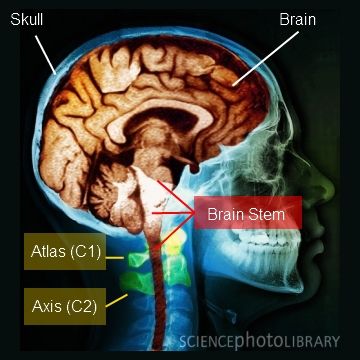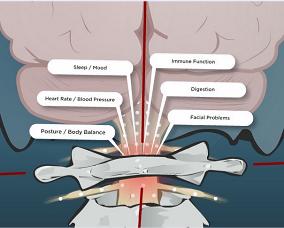

What is the Brainstem? (maybe the most important page to read...)
...and why hasn't anyone told you about it before?
...and why hasn't anyone told you about it before?
I borrowed this Brainstem definition
word-for-word from Wikipedia.
- with medical terminology removed,
- and paragraphs separated for clarification.
(My comments as to why you should know this
information, are in bold)
1. The Brainstem is the posterior part of the brain, adjoining
and structurally continuous with the spinal cord.
Dr J: The Brainstem is the connection between your
upper Brain and the everything else in your Body.
2. The Brainstem provides the main motor and sensory
innervation to the face and neck via the cranial nerves.
Dr J: 1. You have 12 Cranial Nerves - 10 of them are routed
directly through the Brainstem.
2. The cranial nerves send messages for all facial, mouth,
throat, and lip movement from the Brain to the face.
3. The cranial nerves pass most sensory messages from
the sense organs in the head, to the Brain.
Those sense messages include:
1. Control of the movement of the eyes
2. Hearing from the ears,
3. Balance from the ears
4. Taste from the tongue and throat
5. And smells from the nose.
Know anyone with facial pain, a lazy eye,
or sensing problems?
3. Though small, this is an extremely important part of
the brain as the nerve connections of the motor and
sensory systems from the main part of the brain to
the rest of the body pass through the brain stem.
Dr J: All messages from the Brain to the Body, or the
Body to the Brain, must pass though the Brainstem.
If the Brainstem is compromised, it will impact the
accuracy of all the signals that must travel through it.
Know anyone with a problem anywhere?
4. This includes the motor, fine touch, vibration sensation,
proprioception, pain, temperature, itch and crude touch.
Dr J: The Brainstem passes vital sensations and muscle
movement messages to and from the Body.
Know anyone with balance, motion,
or pain problems?
5. The Brainstem also plays an important role in the
regulation of cardiac and respiratory function.
Dr J: The Brainstem helps control our heart rhythm
and breathing functions.
Know anyone with blood pressure
or breathing problems?
(see the Blood Pressure Study Video)
6. It also regulates the central nervous system,
and is pivotal in maintaining consciousness
and regulating the sleep cycle.
Dr J: The Brainstem controls the rest of your central
nerve system - which in turn is responsible for
control of your entire body.
Would you like your brain to function as well
as it is able?
Would you like your whole body to function as well
as it is able?
7. The Brainstem has many basic functions including:
heart rate, breathing, sleeping and eating.
Dr J: So - other than breathing, sleeping, eating,
and heart rate - nothing important :)
And yet, until today, no one has ever mentioned
the Brainstem to you.
Dr J: Do you now know why?
(Hint: We are the only profession with the expressed goal
of removing Brainstem Interference, thus restoring
proper whole body Nerve System function.)
word-for-word from Wikipedia.
- with medical terminology removed,
- and paragraphs separated for clarification.
(My comments as to why you should know this
information, are in bold)
1. The Brainstem is the posterior part of the brain, adjoining
and structurally continuous with the spinal cord.
Dr J: The Brainstem is the connection between your
upper Brain and the everything else in your Body.
2. The Brainstem provides the main motor and sensory
innervation to the face and neck via the cranial nerves.
Dr J: 1. You have 12 Cranial Nerves - 10 of them are routed
directly through the Brainstem.
2. The cranial nerves send messages for all facial, mouth,
throat, and lip movement from the Brain to the face.
3. The cranial nerves pass most sensory messages from
the sense organs in the head, to the Brain.
Those sense messages include:
1. Control of the movement of the eyes
2. Hearing from the ears,
3. Balance from the ears
4. Taste from the tongue and throat
5. And smells from the nose.
Know anyone with facial pain, a lazy eye,
or sensing problems?
3. Though small, this is an extremely important part of
the brain as the nerve connections of the motor and
sensory systems from the main part of the brain to
the rest of the body pass through the brain stem.
Dr J: All messages from the Brain to the Body, or the
Body to the Brain, must pass though the Brainstem.
If the Brainstem is compromised, it will impact the
accuracy of all the signals that must travel through it.
Know anyone with a problem anywhere?
4. This includes the motor, fine touch, vibration sensation,
proprioception, pain, temperature, itch and crude touch.
Dr J: The Brainstem passes vital sensations and muscle
movement messages to and from the Body.
Know anyone with balance, motion,
or pain problems?
5. The Brainstem also plays an important role in the
regulation of cardiac and respiratory function.
Dr J: The Brainstem helps control our heart rhythm
and breathing functions.
Know anyone with blood pressure
or breathing problems?
(see the Blood Pressure Study Video)
6. It also regulates the central nervous system,
and is pivotal in maintaining consciousness
and regulating the sleep cycle.
Dr J: The Brainstem controls the rest of your central
nerve system - which in turn is responsible for
control of your entire body.
Would you like your brain to function as well
as it is able?
Would you like your whole body to function as well
as it is able?
7. The Brainstem has many basic functions including:
heart rate, breathing, sleeping and eating.
Dr J: So - other than breathing, sleeping, eating,
and heart rate - nothing important :)
And yet, until today, no one has ever mentioned
the Brainstem to you.
Dr J: Do you now know why?
(Hint: We are the only profession with the expressed goal
of removing Brainstem Interference, thus restoring
proper whole body Nerve System function.)


click on image to enlarge:
Just some of the functions
of the Brainstem:
of the Brainstem:


featuring The Doctor with "X-Ray" Vision
























